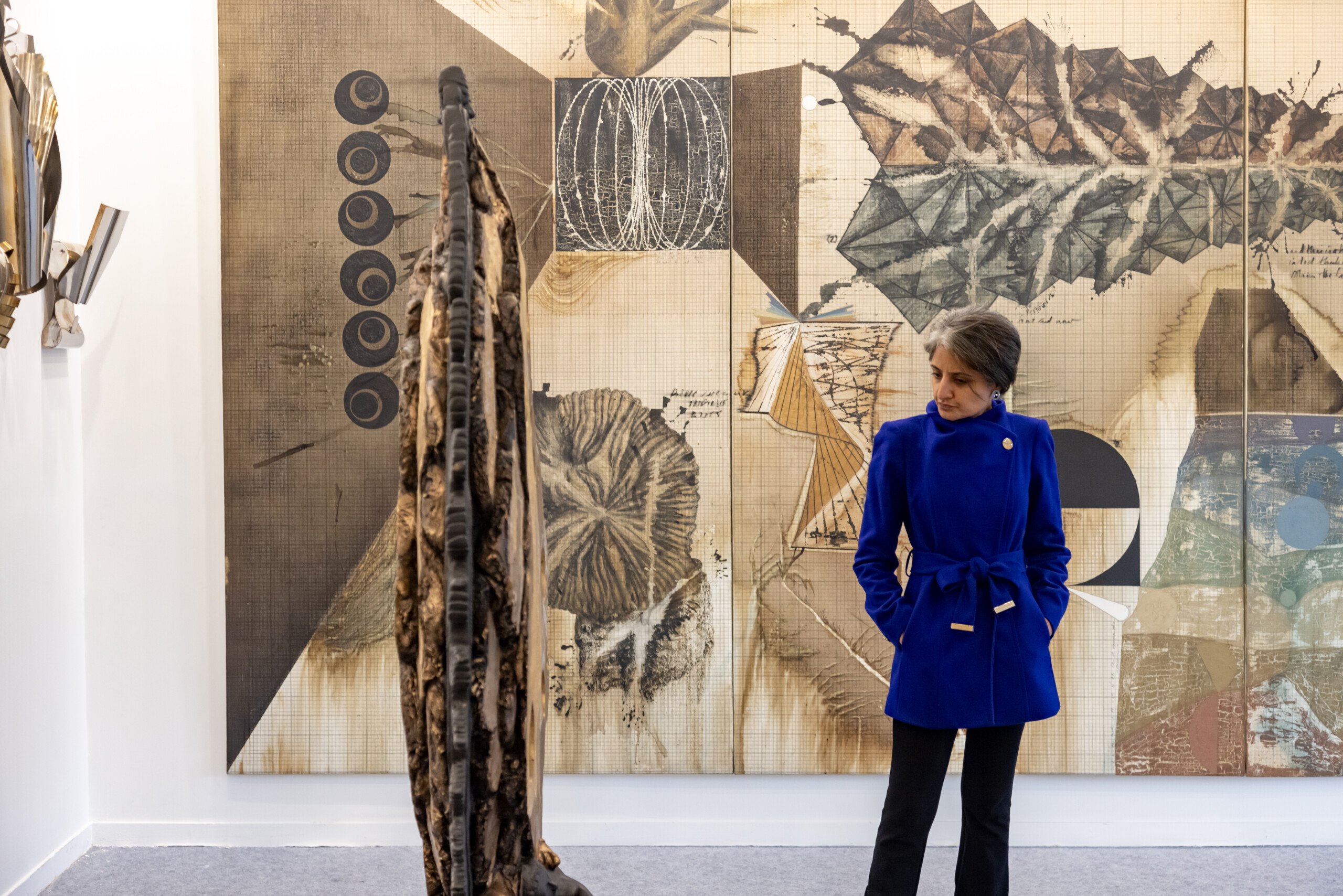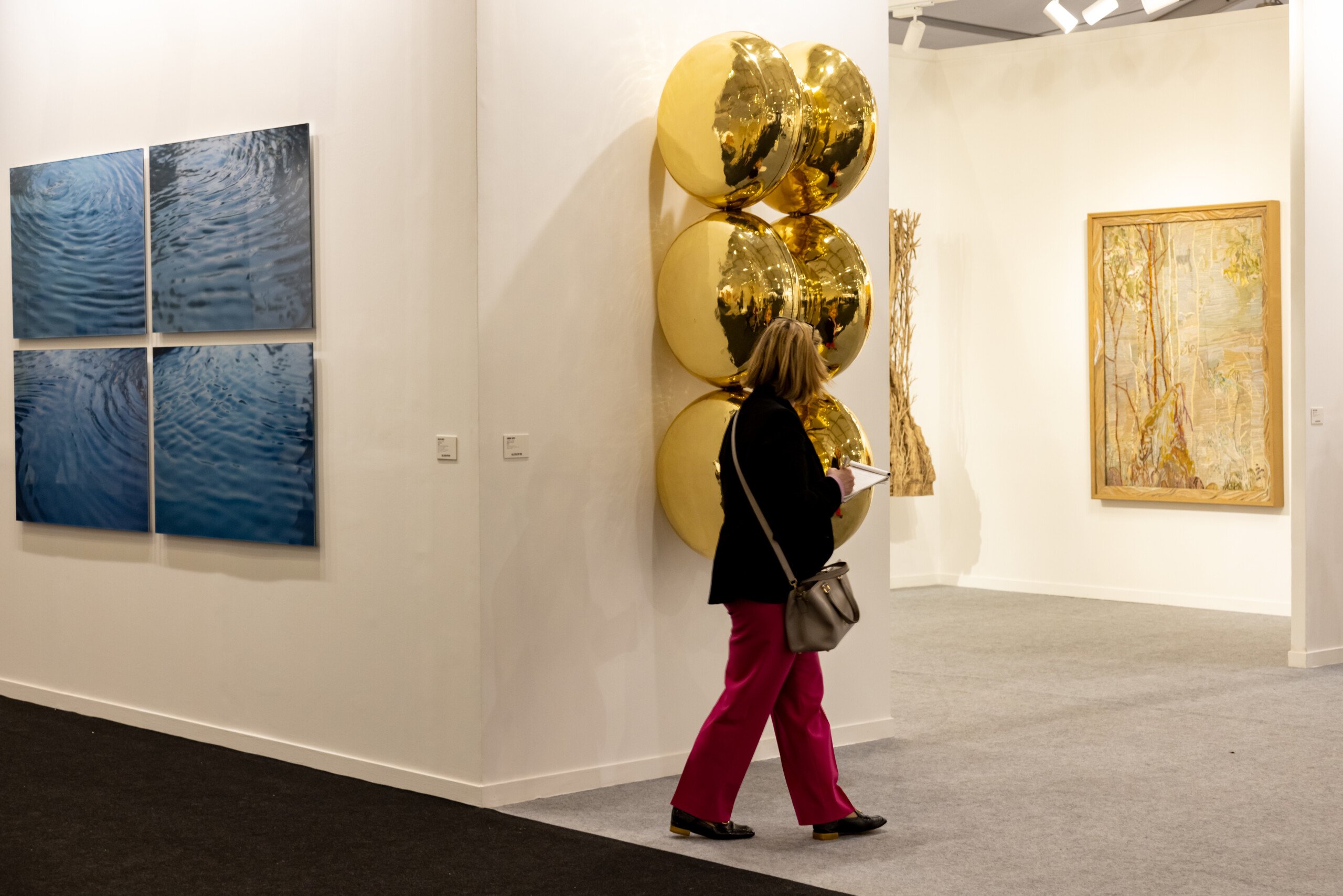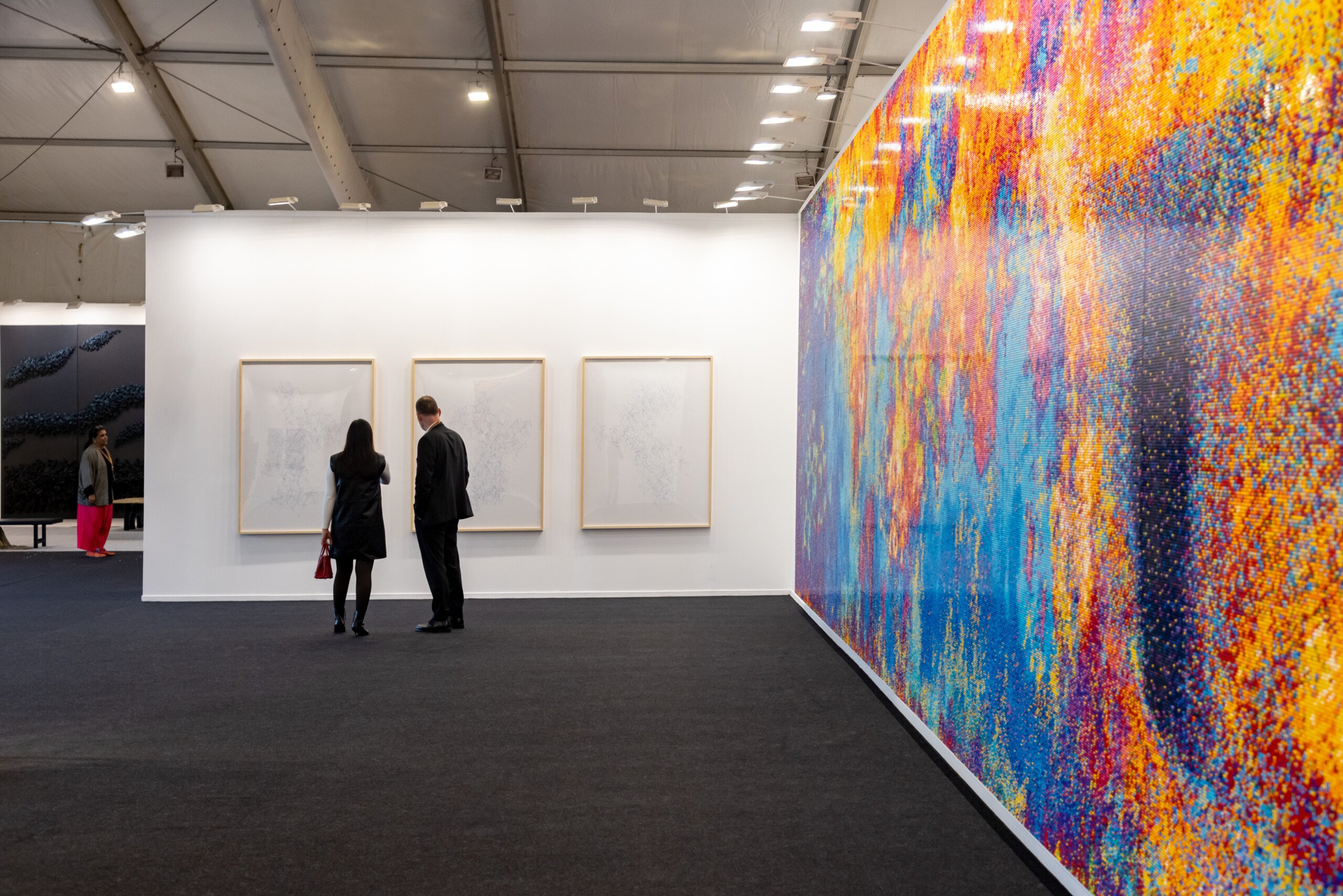Art Fairs
What Was Hot at the India Art Fair? A Report From the Ground
Real-estate firms and philanthropists are spending big as the nation's economy booms, and international dealers are taking notice.

Real-estate firms and philanthropists are spending big as the nation's economy booms, and international dealers are taking notice.

Cleo Roberts-Komireddi

It is an election year in India, with Prime Minister Narendra Modi the current favorite to win a rare third term in May. On Thursday, the day of an interim budget announcement on green growth, the India Art Fair opened its 15th edition, its largest to date with the addition of a new design section. With the economy rosy for some, and a forecast from Goldman Sachs that, of the world’s largest economies, India’s is set to grow at the highest rate, many of the 109 exhibitors at the NSIC Exhibition Grounds in New Delhi were in a jubilant mood.
“For the last six months to a year, the market has been on fire,” said Roshini Vadehra of the hometown Vadehra Gallery, who had sold most of her booth on the opening day, including two Atul Dodiya cabinets for $80,000. A large Tyeb Mehta painting went to an institutional collection for a price in line with auction results, which are currently upwards of $1.8 million. “People are buying across the board,” Vadehra said. “It’s not just the big names. Our gallery show, Zaam Arif, has sold out.”
Things are “frothy,” as one gallerist put it. The government has been fortifying the domestic market, reducing imports and developing infrastructure to hit its target of being a $5 trillion economy in the next five to six years. (India’s GDP now measures about $3.7 trillion, number five worldwide.)
With the rise of on-shoring following the pandemic, foreign direct investment in India has dropped. Meanwhile, over the years, there has been a notable drop-off in blue-chip participant at the India Art Fair, and India still has a total lack of blue-chip outposts, unlike neighboring Southeast Asia. Some see India’s art market as a primarily domestic field, strengthening internally but cut off from global currents. However, the fair, which runs through Sunday, offered reasons for optimism.

“I’ve definitely seen a renewed interest in mid-career artists,” said Shireen Gandhy, the owner of Chemould Prescott Road, whose booth is seen here. Photo courtesy the India Art Fair.
“Middle-market buyers are a real and exciting change, which makes it a more mature market,” the Mumbai-based advisor Jai Dannai said. Demand is such that the India Art Fair, which was used to standing alone, now has some competition: Art Mumbai, which opened in November, bringing with it an influx of new clients from the wider Maharashtran state.
Outside India’s political and economic capitals, there is a desire among gallerists and established collectors to find new audiences for contemporary art. In the absence of sustained state support, the Indian art world thrives on private initiatives. Madras Art Weekend started in 2022, Jodhpur Art Week will launch in November this year, and there is a robust arts program at Bangalore’s airport—all efforts by private organizations to make art accessible.
These initiatives come at a time when India is experiencing a building boom. As its population soars and home sales rise, interior designers and architects are increasingly pointing clients to contemporary art. The Young Collectors Program run by the India Art Fair targets these industries and, through offsite exhibitions and talks at STIR Gallery in South Delhi and a heritage haveli (a traditional house) in Old Delhi, presents works ranging from $120 to $6,300.
Galleries are identifying burgeoning collector bases in tier-two and -three cities like Indore, Surat, and Chandigarh, as well as an increase in buyers from the diaspora. Although, “it’s taking time,” said Bhargavi Gundala, of the Hyderabad gallery Dhi Artspace. “Outside of the main centers, audiences need to be guided and have the intellectual ideas introduced so they see the work as more than decoration.”
Placing art in heavily trafficked public spaces, like malls, has been part of efforts to change perceptions. RMZ Foundation, which is linked to Bangalore developer RMZ Corp, has an art program across its real-estate portfolio in India. At Skyview, its office-block tower housing tech firms in Hyderabad, it has installed major sculptures by artists including Thukral & Tagra and Gigi Scaria. On VIP day, its team was perusing the stands, and acquired a wall sculpture by Viswanath Kuttum from Gurugram-based Art Incept to add to the building.

“In 2012, when we started, there was no interest in our international artists, but slowly people are interested,” said Maurizio Rigillo, the founder of Galleria Continua, whose booth is pictured here. Photo courtesy of the India Art Fair.
It is not just the lower end of the Indian art market that is alive. On the higher end, enthusiasm for modern masters like M. F. Husain and F. N. Souza shows no sign of waning. The limited supply of work and increased visibility in international museums has led to record-breaking prices at auction. Last year, a painting by Amrita Sher-Gil titled The Story Teller (1937) went for just under $7.5 million at SaffronArt, and an untitled Manjit Bawa fetched $2.3 million at Sotheby’s.
Specialists at Christie’s New York, which holds two sales of South Asian modern and contemporary in person each year and one online, have noticed new buying patterns. “We’re seeing first-time buyers coming in and buying at the top end, rather than making smaller purchases, as we usually expect,” said Nishad Avri, who oversees those auctions.
Some speculate that the rise in prices on modern work has pushed buyers toward contemporary art, buoying that field. “I’ve definitely seen a renewed interest in mid-career artists,” said Shireen Gandhy, the owner of Chemould Prescott Road, one of Mumbai’s oldest galleries. By the end of the first day, Gandhy had sold 80 percent of her booth, including Mithu Sen’s A Prayer Unanswered (2023–24), a series of pin-prick images on paper, to the Ishara Art Foundation and the Prabhakar Collection, which are based in Dubai.

A massive Lego piece by Ai Weiwei hangs on a wall of Neugerriemschneider’s booth. Photo courtesy the India Art Fair.
While the majority of galleries at the fair are showing South Asian artists, some have brought a mix of international works, like Neugerriemschneider (of Berlin), Galerie Isa (Mumbai), Marc Straus (New York), and Galleria Continua (San Gimignano, Beijing, Les Moulins, Habana, Roma, São Paulo, Paris, and Dubai).
Maurizio Rigillo, the founder of Continua, who first participated in the fair in 2012, said, “When we started, there was no interest in our international artists, but slowly people are interested.” By the end of the second day, he had sold several Ai Weiwei works at around €300,000 ($324,000), as well as a Nari Ward “in the range of” $400,000. The design-focused Carpenters Workshop (Paris and elsewhere) reported total sales in excess of €1.5 million (about $1.62 million), all to Indian collectors.
New Delhi’s Nature Morte gallery is showing the Polish-German sculptor Alicja Kwade at its Dhan Mill space. It’s Kwade’s first exhibition in India, and so far, more than half her works, priced between €30,000 and €600,000 (about $32,400 to $648,000), have sold to new clients, in India and abroad.
Space for ambitious international shows has been limited in India. But a sea change seems to be occurring. Last year, the Nita Mukesh Ambani Cultural Centre brought Maurizio Cattelan and Pierpaolo Ferrari’s multifarious Toiletpaper project to Mumbai. Meanwhile, the JSW Foundation will open Hampi Art Labs in the South Indian temple town of Vijayanagar on February 6 with a show featuring Ai and Andy Warhol. The Serendipity Arts Foundation has also finalized designs for a Live Museum with exhibition spaces, a theater, an art academy, a residency program, and more in South West Delhi. Thanks to philanthropist Kiran Nadar’s ambitious forthcoming museum in Delhi, which is slated to open in 2026, along with her increased sponsorship of institutional exhibitions outside India, it seems likely that international exchange will intensify.
All of this appears to be catching the attention of old friends of the India Art Fair. A team from the powerhouse Lisson Gallery, which participated in 2009, 2011, and 2012, was on a scouting trip, considering a booth in the future.